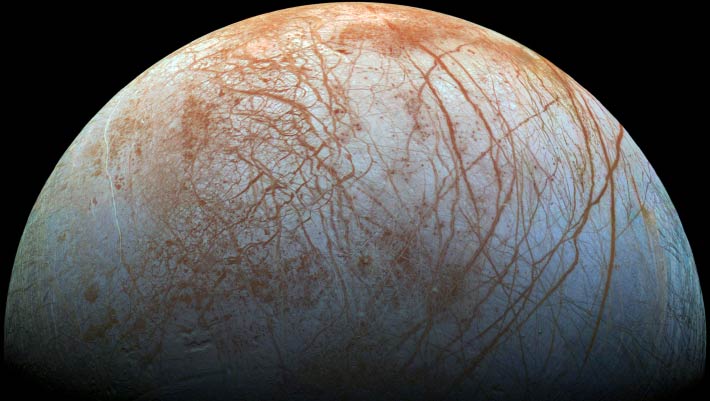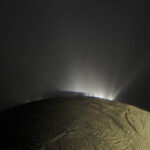Many planetary scientists studying Jupiter’s moon Europa assumed that it formed with a metallic core during or shortly after accretion. New research from Arizona State University contradicts that prediction, instead arguing that Europa may not have started forming its metallic core — if it happened at all — until billions of years after accretion.
The subsurface ocean of Jupiter’s moon Europa lies atop an interior made of metal and silicates. On the basis of gravity data from NASA’s Galileo mission, many scientists argued that Europa’s interior, like Earth, is differentiated into a metallic core and a mantle composed of silicates. Some studies further assumed that Europa differentiated while — or soon after — it accreted, also like Earth. However, Europa probably formed at much colder temperatures, meaning that the icy moon plausibly ended accretion as a mixture containing water-ice and/or hydrated silicates. Trinh et al. investigated the consequences of Europa forming with low initial temperatures (200 to 300 K). Image credit: NASA / JPL-Caltech / SETI Institute.
Europa may have a metamorphic origin for the ocean. While some scientists speculated this, Arizona State University researcher Kevin Trinh and colleagues show that if Europa indeed formed from hydrated rocks, then enough of Europa’s interior should get hot enough to release water directly from the hydrated rocks to form the ocean and ice shell.
“The origin of Europa’s ocean is important because the moon’s potential to support life ultimately depends on the chemical ingredients and physical conditions during the ocean formation process,” Trinh said.
“For most worlds in the Solar System we tend to think of their internal structure as being set shortly after they finish forming.”
“Our work is very exciting because it reframes Europa as a world whose interior has been slowly evolving over its whole lifetime.”
“This opens doors for future research to understand how these changes might be observed in the Europa we see today,” added Arizona State University’s Dr. Carver Bierson.
The existence of a metallic core is deeply tied to Europa’s internal heat, which may also be used to drive seafloor volcanism and contribute to a habitable seafloor environment. However, it is unclear whether Europa generated enough heat to form such a core.
The authors calculated how heat is generated and distributed throughout the moon.
Their novel result came from challenging the assumptions common to Europa modeling: a small moon like Europa could form as a cold mixture of ice, rock, and metal.
However, all of these processes require a hot interior.
A small moon like Europa (~1% of Earth’s mass) may not have enough energy to trigger or sustain Earth-like processes — metallic core formation, seafloor volcanism, and ongoing rock-water geochemistry — which implies that Europa’s habitable potential is uncertain.
The exact time at which Europa formed determines how much heat is available from the radioactive decay of a short-lived isotope of aluminum.
Tidal heating — from gravitational interactions with Jupiter and other moons — also governs how quickly Europa’s interior separates into distinct layers.
Europa’s seafloor may be cool, hydrated, and experience limited (if any) seafloor volcanism.
This new study implies that there may be limited hydrothermal activity and seafloor volcanism at Europa, which may hinder habitability. However, confident predictions require more data.
“Europa is not just a wet, baby Earth. It is its own special world, full of mysteries to unravel,” said Arizona State University’s Dr. Joseph O’Rourke.
The study appears in the journal Science Advances.
_____
Kevin T. Trinh et al. 2023. Slow evolution of Europa’s interior: metamorphic ocean origin, delayed metallic core formation, and limited seafloor volcanism. Science Advances 9 (24); doi: 10.1126/sciadv.adf395



